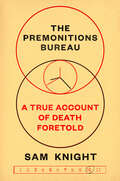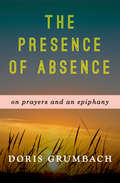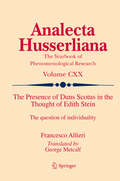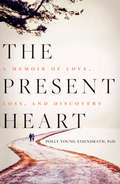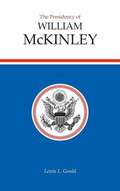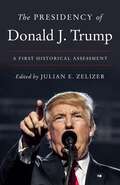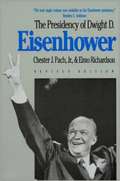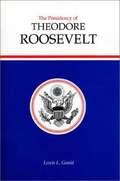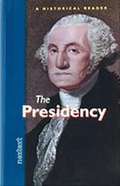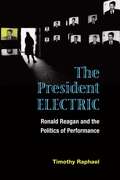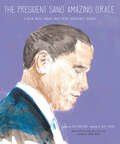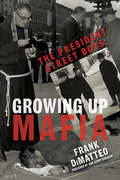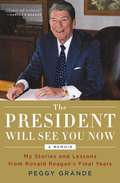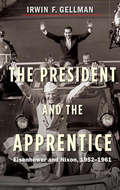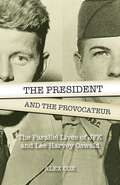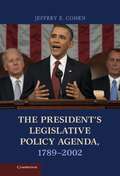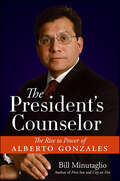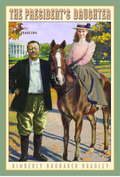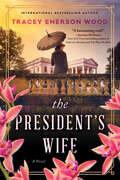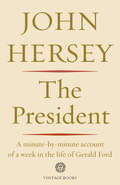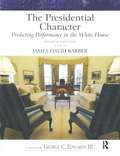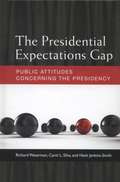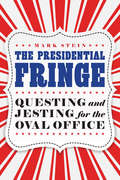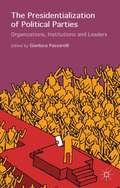- Table View
- List View
The Premonitions Bureau: A True Account of Death Foretold
by Sam Knight&“This is rich, florid, funny history, with undertones of human grief . . . Knight is shrewd and perceptive . . . [he] pushes his material into neurobiology, into the nature of placebos and expectations and self-fulfilling prophecies . . . Knight&’s book is crisp.&” —Dwight Garner, New York Times&“Stunning… An enveloping, unsettling book, gorgeously written and profound.&” —Patrick Radden Keefe, New York Times bestselling author of Say Nothing and Empire of Pain From a rising star New Yorker staff writer, the incredible and gripping true story of John Barker, a psychiatrist who investigated the power of premonitions—and came to believe he himself was destined for an early deathOn the morning of October 21, 1966, Kathleen Middleton, a music teacher in suburban London, awoke choking and gasping, convinced disaster was about to strike. An hour later, a mountain of rubble containing waste from a coal mine collapsed above the village of Aberfan, swamping buildings and killing 144 people, many of them children. Among the doctors and emergency workers who arrived on the scene was John Barker, a psychiatrist from Shelton Hospital, in Shrewsbury. At Aberfan, Barker became convinced there had been supernatural warning signs of the disaster, and decided to establish a &“premonitions bureau,&” in conjunction with the Evening Standard newspaper, to collect dreams and forebodings from the public, in the hope of preventing future calamities.Middleton was one of hundreds of seemingly normal people, who would contribute their visions to Barker&’s research in the years to come, some of them unnervingly accurate. As Barker&’s work plunged him deeper into the occult, his reputation suffered. But in the face of professional humiliation, Barker only became more determined, ultimately realizing with terrible certainty that catastrophe had been prophesied in his own life.In Sam Knight&’s crystalline telling, this astonishing true story comes to encompass the secrets of the world. We all know premonitions are impossible—and yet they come true all the time. Our lives are full of collisions and coincidence: the question is how we perceive these implausible events and therefore make meaning in our lives. The Premonitions Bureau is an enthralling account of madness and wonder, of science and the supernatural. With an unforgettable ending, it is a mysterious journey into the most unsettling reaches of the human mind.
The Presence of Absence: On Prayers and an Epiphany (Inspirational Ser.)
by Doris GrumbachThe story of an ecstatic spiritual moment—and the search to experience it again When she was twenty-seven years old, writer Doris Grumbach had an epiphany. It was as if God were right there beside her, and she had a &“feeling of peace so intense that it seemed to expand into ineffable joy.&” After this fleeting moment, Grumbach became determined to recapture what she had felt. The Presence of Absence is the story of her fifty-year search. Grumbach is an open-minded and skilled seeker, and she writes candidly of the people she has met along the way. She details how she lost her path after decades of going to her Protestant church and writes of her turn to personal spirituality. In her quest to find God, she encounters a multitude of philosophies and gives all of them their due. She reads the works of Thomas Merton and Simone Weil, seeks the advice of her seminary-attending daughter, and studies the Psalms. Despite the setbacks of disease, injury, and ego, Grumbach perseveres in her pursuit of beauty and proof in the absence.
The Presence of Duns Scotus in the Thought of Edith Stein
by Francesco AlfieriThis book examines the phenomenological anthropology of Edith Stein. It specifically focuses on the question which Stein addressed in her work Finite and Eternal Being: What is the foundational principle that makes the individual unique and unrepeatable within the human species? Traditional analyses of Edith Stein's writings have tended to frame her views on this issue as being influenced by Aristotle and Thomas Aquinas, while neglecting her interest in the lesser-known figure of Duns Scotus. Yet, as this book shows, with regard to the question of individuality, Stein was critical of Aquinas' approach, finding that of Duns Scotus to be more convincing. In order to get to the heart of Stein's readings of Duns Scotus, this book looks at her published writings and her personal correspondence, in addition to conducting a meticulous analysis of the original codexes on which her sources were based. Written with diligence and flair, the book critically evaluates the authenticity of Stein's sources and shows how the position of Scotus himself evolved. It highlights the originality of Stein's contribution, which was to rediscover the relevance of Mediaeval scholastic thought and reinterpret it in the language of the Phenomenological school founded by Edmund Husserl.
The Present Heart: A Memoir of Love, Loss, and Discovery
by Polly Young-EisendrathAfter a chance encounter with a handsome, idealistic stranger on a plane in 1969, Polly Young-Eisendrath rediscovered Ed Epstein a decade later when she least expected it. After untangling themselves from their existing relationships, they married in 1985 and spent the next 25 years together. They were soul mates, but in 2001, Ed (at the vital age of 53) began to show signs of Alzheimer's disease. Over the next 10 years, as her husband gradually reversed his mental maturity, Young-Eisendrath was faced with the question, what is love? The Present Heart is an insightful journey of living in the present moment. In a deeply moving yet unsentimental voice, Young-Eisendrath draws on her lifelong practices of Buddhism and psychoanalysis and her own unique view of love, as well as a circle of profound thinkers including author Abigail Thomas, psychoanalyst Nancy McWilliams, and Buddhist teacher Shinzen Young.A thoughtful meditation on the human experience, The Present Heart shows how our most intimate relationships, often the source of our greatest pain, can prove to be our path to spiritual enlightenment. The book offers a new perspective on how to maintain engaged, reciprocal relationships—with a partner, parent, child, or friend—under any and all circumstances.
The Presidency Of William McKinley
by Lewis L. GouldIn this interpretation of the McKinley presidency Lewis L. Gould contends that William McKinley was the first modern president. Making use of extensive original research in manuscript collections in the United States, Great Britain, and France, Gould argues that during McKinley's four and a half years in the White House the executive office began to resemble the institution as the twentieth century would know it. He rejects the erroneous stereotypes that have long obscured McKinley's historical significance: McKinley as the compliant agent of Mark Hanna or as an irresolute executive in the Cuban crisis that led to war with Spain. He contends that McKinley is an important figure in the history of the United States because of the large contributions he made to the strengthening and broadening of the power of the chief executive. While this volume touches on many aspects of McKinley's leadership, the core of it relates to the coming of the Spanish-American War, the president's conduct of the war itself, and the emergence of an American empire from 1898 to 1900. According to Gould, the Spanish-American War was not the result presidential weakness or of cowardice before public hysteria. McKinley sought to persuade Spain to relinquish Cuba peacefully, turning to war only when it became apparent that Madrid would never acquiesce. During the war, McKinley effectively directed the American military effort and the diplomacy that brought territorial acquisitions and peace. The process of making peace with Spain--involving, as it did, American annexation of the Philippines--and of securing the ratification of the resulting treaty in the Senate underscored McKinley's expansive view of presidential power. He functioned as chief diplomat, from the sending of senators on the peace commission to the personal supervision of the terms of the negotiation. At home he made tours of the West and South in 1898 to lead popular opinion to his position as no president had done before him. For the Senate he evidenced a readiness to dispense patronage, woo votes with personal persuasion, and marshal the resources of the political system behind his treaty. Later episodes in McKinley's administration support Gould's thesis. In administering Puerto Rico and Cuba and in suppressing an insurrection in the Philippines, McKinley relied further on the war power and continued to shape affairs from the White House. He sent troops to china during the Boxer Rebellion in 1900 without congressional authorization, governed the new possessions through presidential commissions, and allowed Capitol Hill only a subsidiary role in the process. By 1901 the nation had an empire and a president whose manner and bearing anticipated the imperial executives of six decades later. Gould does not argue that McKinley was a great president. He maintains, instead, that what McKinley contributed to the office, the examples he offered and the precedents he set make him an important figure in the emergence of the modern presidency in this century.
The Presidency of Donald J. Trump: A First Historical Assessment
by Julian E. Zelizer, EditorLeading historians provide perspective on Trump’s four turbulent years in the White HouseThe Presidency of Donald J. Trump presents a first draft of history by offering needed perspective on one of the nation’s most divisive presidencies. Acclaimed political historian Julian Zelizer brings together many of today’s top scholars to provide balanced and strikingly original assessments of the major issues that shaped the Trump presidency.When Trump took office in 2017, he quickly carved out a loyal base within an increasingly radicalized Republican Party, dominated the news cycle with an endless stream of controversies, and presided over one of the most contentious one-term presidencies in American history. These essays cover the crucial aspects of Trump’s time in office, including his administration’s close relationship with conservative media, his war on feminism, the solidification of a conservative women’s movement, his response to COVID-19, the border wall, growing tensions with China and NATO allies, white nationalism in an era of Black Lives Matter, and how the high-tech sector flourished.The Presidency of Donald J. Trump reveals how Trump was not the cause of the political divisions that defined his term in office but rather was a product of long-term trends in Republican politics and American polarization more broadly.With contributions by Kathleen Belew, Angus Burgin, Geraldo Cadava, Merlin Chowkwanyun, Bathsheba Demuth, Gregory Downs, Jeffrey Engel, Beverly Gage, Nicole Hemmer, Michael Kazin, Daniel C. Kurtzer, James Mann, Mae Ngai, Margaret O’Mara, Jason Scott Smith, Keeanga-Yamahtta Taylor, and Leandra Zarnow.
The Presidency of Dwight D. Eisenhower
by Elmo RichardsonThe focus of this revision is not how Eisenhower made policy, but how his decisions shaped American life in the 1950s and beyond. In this first post-revisionist study of the Eisenhower presidency, historian Chester Pach reaches beyond the issues the revisionists raised: Was Eisenhower in command of his own administration? Did he play a significant role in shaping foreign and domestic policy? Drawing on the wide range of works published within the past decade, Pach expands Elmo Richardson's 1979 study by nearly one third. In addition to new material on national security policy, Pach deepens the analysis of Eisenhower's leadership and managerial style and explores the significance of the decisions Eisenhower made on a whole range of critical issues, from civil rights to atomic testing. By emphasizing the fundamental failings of Eisenhower's presidency, Pach swims against the stream of recent scholarship. He concludes, for example, that Eisenhower's commitment to support South Vietnam in 1954, with its attendant responsibilities and consequences, was far more important—and ultimately disastrous—than his refusal to intervene with military force in support of the French in 1954. Eisenhower's unleashing of the CIA (in Iran, Guatemala, and elsewhere) also draws sharp criticism, as does his timid and ineffective handling of McCarthy.
The Presidency of Theodore Roosevelt (American Presidency Series)
by Lewis L. GouldEight decades after he left the White House, Theodore Roosevelt remains the most exciting of the twentieth-century presidents. Candidates evoke the name of "Teddy" Roosevelt to show that they are strong in foreign policy and devoted to the environment. His phrases—the "bully pulpit," the "big stick," and the "strenuous life"—are part of the language. Roosevelt was more than an important contributor to the evolution of the modern institution of the presidency. He personalized the office in a way that had not occurred since Andrew Jackson. In many respects, none of Roosevelt's successors since 1909 has equaled his impact on the popular mind. Accounts of Roosevelt's life usually emphasize the departures that he made in how the presidency was conducted. While he brought freshness, youth, and energy to his duties, he did not work in a historical vacuum. William McKinley had revitalized the office between 1897 and 1901, and Roosevelt built on those accomplishments. In time his flair and charisma eclipsed the work of his predecessor. Nonetheless, Roosevelt was a key player in a general strengthening of the presidency that took place during the quarter century after the election of 1896. It does not diminish his record to recognize that he was never the sole architect of the modern presidency in its formative stage.
The Presidency: A Historical Reader
by Ethel WoodEssays by a variety of historians on different Presidents and their effects on American history.
The President Electric: Ronald Reagan and the Politics of Performance
by Timothy RaphaelWhen Ronald Reagan first entered politics in 1965, his public profile as a performer in radio, film, television, and advertising and his experience in public relations proved invaluable political assets. By the time he left office in 1989, the media in which he trained had become the primary source for generating and wielding political power. The President Electric: Ronald Reagan and the Politics of Performance reveals how the systematic employment of the techniques and technologies of mass-media performance contributed to Reagan’s rise to power and defined his style of governance. The President Electric stands out among books on Reagan as the first to bring the rich insights of the field of performance studies to an understanding of the Reagan phenomenon, connecting Reagan's training in electronic media to the nineteenth-century notion of the "fiat of electricity"---the emerging sociopolitical power of three entities (mechanical science, corporate capitalism, and mass culture) that electric technology made possible. The book describes how this new regime of cultural and political representation shaped the development of the electronic mass media that transformed American culture and politics and educated Ronald Reagan for his future role as president.
The President Sang Amazing Grace: A Book About Finding Grace After Unspeakable Tragedy
by Zoe MulfordThis picture book about Barack Obama singing with a grieving nation after the Charleston church shooting “represents an important moment in U.S. history” (Kirkus Reviews).When nine people were killed in a historic black church in Charleston, South Carolina, in 2015, the nation grieved as one, and when President Barack Obama sang “Amazing Grace” during his eulogy for Reverend Clementa Pinckney, it was acknowledged as one of the most powerful moments of his presidency. Singer/songwriter Zoe Mulford was so moved that she wrote the song “The President Sang Amazing Grace,” which was sung by Joan Baez and illustrated by filmmaker and painter Jeff Scher for a video that has been viewed countless times. This book presents the lyrics to the song, Scher’s paintings, excerpts from Obama’s eulogy, biographies of those who were killed, historical context, and sheet music.
The President Street Boys: Growing Up Mafia
by Frank Dimatteo"When Mom got out of jail, it was great having her home."Mondo the Dwarf. Frankie Shots. Jospeh "Little Lolly Pop" Carna. Larry "Big Lolly Pop" Carna. Salvatore "Sally Boy" Marinelli. Johnny Tarzan. Louie Pizza. Sally D, Bobby B, Roy Roy, and Punchy.They were THE PRESIDENT STREET BOYS of Brooklyn, New York.Frank Dimatteo was born into a family of mob hitmen. His father and godfather were shooters and bodyguards for infamous Mafia legends, the Gallo brothers. His uncle was a capo in the Genovese crime family and bodyguard to Frank Costello. Needless to say, DiMatteo saw and heard things that a boy shouldn't see or hear.He knew everybody in the neighborhood. And they knew him. . .and his family. And does he have some wild stories to tell. . .From the old-school Mafia dons and infamous "five families" who called all the shots, to the new-breed "independents" of the ballsy Gallo gang who didn't answer to nobody, Dimatteo pulls no punches in describing what it's really like growing up in the mob. Getting his cheeks pinched by Crazy Joe Gallo until tears came down his face. Dropping out of school and hanging gangster-style with the boys on President Street. Watching the Gallos wage an all-out war against wiseguys with more power, more money, more guns. And finally, revealing the shocking deathbed confessions that will blow the lid off the sordid deeds, stunning betrayals, and all-too-secret history of the American Mafia.Originally self-published as Lion in the BasementRaves For THE PRESIDENT STREET BOYS: Growing Up Mafia"Frankie D was born and raised in this life--and he's still alive and still free. They don't come any sharper then Frankie D. A real gangster story. Read this book!" --Nicky "Slick" DiPietro, New York City"I know Frankie D from when i was a kid living in South Brooklyn. It was hard reading about my father, Gennaro "Chitoz" Basciano, but I knew it was the truth. Frankie's book is dead on the money--I couldn't put it down." --Eddie Basciano, somewhere in Florida"It's been forty years since I've been with Frankie D doing our thing on President Street. This book was like a flashback, Frankie D nails it from beginning to the end. Bravo, from one of the President Street Boys." --Anthony "Goombadiel" DeLuca, Brooklyn, New York"As a neighborhood kid I grew up around President Street and know firsthand the lure of 'the life' as a police officer and as a kid that escaped the lure. I can tell you the blind loyalty that the crews had for their bosses--unbounded, limitless, and dangerous. As the Prince of President Street, Frank Dimatteo, is representative of a lost generation of Italian Americans. If any of this crew had been given a fair shot at the beginning they would have been geniuses in their chosen field." --Joseph "Giggy" Gagliardo, Retired DEA Agent, New York City"The President Street Boys takes me back as if it was a time machine. Its authenticity is compelling reading for those interested in what things were really like in those mob heydays; not some author's formulation without an inkling of what was going on behind the scenes. I loved the book because I was there, and know for sure readers will love it too." --Sonny Girard, author of Blood of Our Fathers and Sins of Our Sons
The President Will See You Now: My Stories and Lessons from Ronald Reagan's Final Years
by Peggy GrandeAn affectionate and intimate memoir about Ronald Reagan by his longtime personal assistant, who worked closely with the president for 10 years after he left the White House.In The President Will See You Now, devoted Reagan insider Peggy Grande shares behind-the-scenes stories, intimate moments, and insights into one of America's most beloved presidents. Grande, who started in the Office of Ronald Reagan as a college student and earned her way into a coveted role as the president's Executive Assistant, offers an unparalleled perspective on the post-presidency of a political icon. Grande's stories and never-before-seen photos show a unique, private side to a public figure and leader who reshaped conservatism, ushered in an era of prosperity, and helped spur the end of the Cold War. Grande reveals what day-to-day life was like in Reagan's California office, including the former president's relationship with the First Lady and his interactions with friends, world leaders, and everyday Americans. Grande recalls how Reagan kept a vigorous schedule for years after he left the White House, his robust engagement with others, and ongoing political advocacy. Despite his eventual Alzheimer's diagnosis, Grande shows how Ronald Reagan remained true to core beliefs, his gentlemanly kindness, and his undying hope for his country. Today the Reagan legacy looms over American politics more than ever. Grande reminds readers why: When Ronald Reagan was president, we not only loved ourselves but also loved America, and the American values he represented: faith, optimism, and patriotism.
The President and the Apprentice
by Irwin F. Gellman"Irwin Gellman has emerged from years in the archives to tell the fascinating story of President Dwight Eisenhower and his relationship with his vice president, Richard Nixon. Gellman dispels the fog that has long enveloped this subject and casts new light on a critical Cold War presidency. Masterfully written, The President and the Apprentice is a must-read for anyone who, like me, loves good political history. "--Allen Matusow, author of The Unraveling of America More than half a century after Eisenhower left office, the history of his presidency is so clouded by myth, partisanship, and outright fraud that most people have little understanding of how Ike's administration worked or what it accomplished. We know--or think we know--that Eisenhower distrusted his vice president, Richard Nixon, and kept him at arm's length; that he did little to advance civil rights; that he sat by as Joseph McCarthy's reckless anticommunist campaign threatened to wreck his administration; and that he planned the disastrous 1961 Bay of Pigs invasion of Cuba. None of this is true. The President and the Apprentice reveals a different Eisenhower, and a different Nixon. Ike trusted and relied on Nixon, sending him on many sensitive overseas missions. Eisenhower, not Truman, completed the desegregation of the military. Eisenhower and Nixon, not Lyndon Johnson, pushed the Civil Rights Act of 1957 through the Senate. Eisenhower was determined to bring down McCarthy and did so. Nixon never, contrary to recent accounts, saw a psychotherapist, but while Ike was recovering from his heart attack in 1955, Nixon was overworked, overanxious, overmedicated, and at the limits of his ability to function. Based on twenty years of research in numerous archives, many previously untouched, this book offers a fresh and surprising account of the Eisenhower presidency. "Irwin Gellman's superb research and plausible reconstruction of the Eisenhower-Nixon relationship may well revolutionize the meaning of historical revisionism. The President and the Apprentice is an unsettling tour de force. "--David Levering Lewis, author of King: A Biography and W. E. B. Du Bois: A Biography, winner of the Pulitzer Prize for Biography
The President and the Provocateur
by Alex CoxPresident John F. Kennedy was said to have been murdered by a lone crazed gunman in a Dallas motorcade a half-century ago. The accused killer, Lee Harvey Oswald, was also murdered under mysterious circumstances just a couple days later.Alex Cox, like most of the American public, does not buy into the moth-eaten establishment tale about the regicide. The President and the Provocateur is not the usual conspiracy volume, and is structured almost like the film Rashomon, including varying views of the story with different fonts and sizes.The Kennedy assassination saga has obsessed filmmaker Alex Cox (Repo Man, Sid & Nancy) for most of his life. The President and The Provocateur is Cox's informed meditation on the conspiratorial tale, and as such is an imaginative rendering of the parallel structures of the lives of John F. Kennedy and Lee Harvey Oswald.Cox's films are available from the renowned distributors Criterion and Anchor Bay. They include Repo Man, Sid and Nancy, and Walker.
The President'S Legislative Policy Agenda, 1789-2002
by Jeffrey E. CohenJeffrey E. Cohen asks why U. S. presidents send to Congress the legislative proposals that they do and what Congress does with those proposals. His study covers nearly the entire history of the presidency, from 1789 to 2002. The long historical scope allows Cohen to engage competing perspectives on how the presidency has developed over time. He asks what accounts for the short- and long-term trends in presidential requests to Congress, what substantive policies and issues recommendations are concerned with, and what factors affect the presidential decision to submit a recommendation on a particular issue. The President's Legislative Policy Agenda, 1789-2002 argues that presidents often anticipate the Congressional reaction to their legislative proposals and modify their agendas accordingly.
The President's Counselor: The Rise to Power of Alberto Gonzales
by Bill MinutaglioThe first and only biography of the most controversial u.s. Attorney general in recent memoryIn defiance of expectations, statistics, and stereotypes, Alberto Gonzales has risen to become one of the most powerful men in America. Gonzales has been the nexus for key policy points for the Bush administration, and holds inflammatory and very influential positions on issues that seize and polarize the nation—privacy, capital punishment, and torture.Gonzales's unyielding loyalty to George W. Bush—during a time when to call his presidency "controversial" would be an understatement of massive proportions—is a fascinating study in the politics of ambition.From his modest beginnings in Humble, Texas, to his stone-faced refusal to buckle under the pressure of dissenters, The President's Counselor provides never-seen insight into the man whose influence over a very powerful president in very pressing times will undoubtedly impact people here and abroad for years to come.
The President's Daughter
by Kimberly Brubaker BradleyETHEL IS 10 YEARS OLD in 1901 when her family’s life changed forever. Suddenly, Father is not only a famous cowboy, war hero, and politician, but also President Theodore Roosevelt, leader of the United States—and Ethel has a new place to call home. The White House is older and stuffier than Ethel imagined, but there’s never a dull moment with her adventurous family around. Ethel would love to spend every day following Father on horseback rides and scrambles through neighboring Rock Creek Park. Instead, Ethel has to stay at boarding school during the week, where nothing she does feels right and none of the girls seem to like her. Ethel’s parents keep telling her to keep her chin up and be patient, but it’s not easy being the president’s daughter. Ethel wishes she could be as courageous as father and make her family proud. When her fashionable older sister arrives home, Ethel feels new hope. Sister knows the secret of being brave and making friends, and she’s willing to share it. All Ethel needs to do is take one outrageous dare. From the Hardcover edition.
The President's Wife: A Novel
by Tracey Enerson Wood"A vivid portrait of a woman whose remarkable role and achievements in history have largely been relegated to the shadows... A fascinating read!" —Kristina McMorris, New York Times bestselling author of Sold on a Monday and The Ways We HideFrom the USA Today bestselling author of The Engineer's Wife comes an incredible historical novel about the First Lady who clandestinely assumed the presidency. Socialite Edith Bolling has been in no hurry to find a new husband since she was widowed, preferring to fill her days with good friends and travel. But the enchanting courting of President Woodrow Wilson wins Edith over and she becomes the First Lady of the United States. The position is uncomfortable for the fiercely independent Edith, but she's determined to rise to the challenges of her new marriage—from the bloodthirsty press to the shadows of the first World War.Warming to her new role, Edith is soon indispensable to her husband's presidency. She replaces the staff that Woodrow finds distracting, and discusses policy with him daily. Throughout the war, she encrypts top- secret messages and despite lacking formal education becomes an important adviser. When peace talks begin in Europe, she attends at Woodrow's side. But just as the critical fight to ratify the treaty to end the war and create a League of Nations in order to prevent another, Woodrow's always-delicate health takes a dramatic turn for the worse. In her determination to preserve both his progress and his reputation, Edith all but assumes the presidency herself.Now, Edith must contend with the demands of a tumultuous country, the secrets of Woodrow's true condition, and the potentially devastating consequences of her failure. At once sweeping and intimate, The President's Wife is an astonishing portrait of a courageous First Lady and the sacrifices she made to protect her husband and her country at all costs.
The President: A Minute-by-minute Account of a Week in the Life of Gerald Ford
by John HerseyThe President has given me permission to take a kind of voyage with him—to watch him closely through a working week….I will be with him, most of the time, hour in and hour out…. At 8:33 on a rainy Monday in March, 1975, John Hersey sits down on a straight cane-backed chair in the Oval Office to begin soaking up impressions of what happens—in post-Watergate Washington—at the center of American power. Through five and a half days, he will stay close to the President, observing him as he consults with his own staff, with members of Congress, with his Cabinet, with Rockefeller; watching him on the exercise bike, at the barber’s, greeting Miss America: absorbing his confidences as he talks after dinner, in the private quarters of the White House, about his childhood and about his college years when it was difficult to make ends meet. Following the President, Hersey observes in detail all the important moments—as well as the incidental ones—that show what Gerald Ford is like on the job. In this extraordinary book he builds a brilliant and revealing portrait, letting the reader see Ford’s strengths and limitations. And so perceptively does Hersey draw significance from his observations that the insights seem to explode like time bombs. I have seen all week that it is not easy for Gerald Ford…to make what he refers to, in the language of umpires, as “a tough call.” Yet once he has made such a decision, he does not agonize…he becomes convinced of its rightness and is stubborn in its defense…. In reading The President, each of us emerges knowing more than ever before, not only about this imperturbable “iron” man, the first President we did not elect, but also about how the Presidency really operates. In John Hersey’s report we come to understand—the man, and the things that persuade him. And we come to sense…how good it would be if in some way he could speak—good listener that he is—one-to-one with ordinary men and women, his constituents, from whom he has somehow drifted so far away.
The Presidential Character: Predicting Performance in the White House (Fourth Edition)
by James David BarberWhat should we look for in a president? This timeless question begs reconsideration in light of today's crucial presidential election season. To that end, The Presidential Character, James David Barber's examination of who has the potential to occupy the highest office in the land - and why - is being reissued as the newest addition to the Longman Classics in Political Science series. Arguing that patterns in a person's character, world view, and political style can help us anticipate their performance as president, this classic text offers explanations and predictions of the performance of past presidents and presidential candidates.
The Presidential Expectations Gap: Public Attitudes Concerning The Presidency
by Richard Waterman Hank Jenkins-Smith Carol L. SilvaFor decades, public expectations of U. S. presidents have become increasingly excessive and unreasonable. Despite much anecdotal evidence, few scholars have attempted to test the expectations gap thesis empirically. This is the first systematic study to prove the existence of the expectations gap and to identify the factors that contribute to the public’s disappointment in a given president. Using data from five original surveys, the authors confirm that the expectations gap is manifest in public opinion. It leads to lower approval ratings, lowers the chance that a president will be reelected, and even contributes to the success of the political party that does not hold the White House in congressional midterm elections. This study provides important insights not only on the American presidency and public opinion, but also on citizens’ trust in government.
The Presidential Fringe: Questing and Jesting for the Oval Office
by Mark SteinThis offbeat slice of American history places the story of our great republic beneath an unexpected lens: that of fringe candidates for president of the United States. Mark Stein explores how their quest for our nation&’s highest office helped to amplify voices otherwise quashed during their day. His careening tour through elections past includes the efforts of true pioneers in the quest for social equality in our country: the first woman to run for president, Victoria Woodhull in 1872; the first African American to run for president, George E. Taylor in 1904; and the first openly gay cross-dressing candidate for president, Joan Jett Blakk in 1992. But The Presidential Fringe also takes a look at those who would jest their way into the Oval Office, from comedians such as Will Rogers and Gracie Allen to Pat Paulsen and Stephen Colbert. Along the way, Stein shows how even seemingly zany candidates, such as &“Live Forever&” Jones, Vegetarian Party candidate John Maxwell, Flying Saucer Party candidate Gabriel Green, or, most recently, Vermin Supreme, provide extraordinary insights of clarity into who we were when they ran for president and how we became who we are today. Ultimately, Stein&’s examination reveals that it was often precisely these fringe candidates who planted the seeds from which mainstream candidates later harvested genuine, positive change. Written in Stein&’s direct and witty style, The Presidential Fringe surveys and portrays an American landscape rife with the unlikely, unassuming, unexpected, and (in a few cases) unbalanced presidential hopefuls who, in their own way, have contributed to this nation&’s founding quest to form a more perfect Union.
The Presidential Republic
by Jean BlondelThis study presents the presidential republic as the most widespread form of government in the contemporary world and looks at the countries which pioneered that development. It assesses the development of presidential republics and looks as the variety of national arrangements and practices, whose common characteristics are to constitute 'presidential republics', and the positioning of this regime alongside monarchies and parliamentary republics. It also addresses the part played by presidential leadership in helping to legitimise the regimes of the new countries. Offering an insight into presidential republics across Latin America, Africa and the Ex-soviet union, this text is a seminal work on political regimes and essential reading for all students and scholars with an interest in political institutions and leadership world-wide.
The Presidentialization of Political Parties: Organizations, Institutions and Leaders
by Gianluca PassarelliThis book explains why the level of party presidentialization varies from one country to another. It considers the effects of constitutional structures as well as the party's original features, and argues that the degree of party presidentialization varies as a function of the party's genetics.
